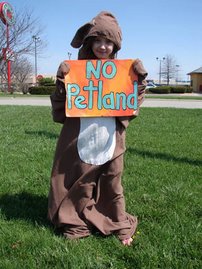Luciana's perfect day...



"Catching some frogs, a little sight seeing, catching some turtles, some sight seeing, catching some frogs--you know. Today is the perfect day!"
I have to chuckle at these pictures of her smile. You can see that front tooth just barely hanging on--it kind of sticks right out there. I was so worried that she would lose it while we were camping--I mean really LOSE it. It's still hanging in there, though.
She did start out clean, but as you can see from the last pics, L's perfect day ends a little bit on the dirty side. ;) These pics are from the day we spent hiking in Copper Falls State Park. It was pretty close to perfect. Even D enjoyed it, and she's not nearly the nature girl L is. D was dismayed to find that she recognizes and can identify more plants and trees than what she thinks is cool. She was horrified at her knowledge, because as she says, she's not into that stuff. I just laugh at her. Who is into that stuff at 16-17. I'm sure she will be a kick-ass gardener when she grows up--it's in her blood. And, since she's stuck with all that pesky knowledge, she might as well use it!
One of the things Mark and I like to do when camping (once the girls are settled and sleeping in the tent) is go back out and sit by the campfire in the pitch dark. The stars are beautiful. I love the woods at night--the sounds, the curiosity about which creatures may visit, pretty much everything. The first night we were out late at the fire (it was between midnight and 1:00), we noticed something glowing quite brightly that wasn't glowing before. It was so bright, we both thought when walking over to check it out, that someone had broken a light stick and spilled out the phosphorescent liquid. When we got close to the 'light', we saw that it was pieces from the inside of a log in the woods that L had been chipping out earlier that day. Every piece of wood from inside this log was glowing bright enough to be a nightlight. It was very cool. Niether of us had seen it before. We tried to have the girls stay up later, until it was pitch black out, and show them the next night, but the glow was minimal. In watching the wood, we discovered that it doesn't get brightly phosphorescent until after midnight--around 1:00 and later were the best times to see it. Mark figured it was a phosphorescent fungus that was growing inside the rotting wood, but we wanted to look it up to confirm when we got home. We tried to get pics with the camera and videotaping it, but it doesn't show up on either format. Here's some info about this, and if you've never seen it, try! It is beyond cool!
This type of glow was noted by Aristotle more than 2000 years ago. It is a bioluminescence caused by a wood-rotting fungus and is akin to the light of the glow-worm, firefly and lantern fish. The mechanism is the oxidation of luciferin, a light-emitting compound, mediated by the enzyme luciferase.
Many micro-organisms luminesce, including the vegetative filaments of fungi. One of the most common and spectacular is the honey fungus toadstool (Armillaria mellea). It is a serious and destructive parasite of many trees and is probably what the questioner saw. The infested wood, and the strap-like strands which spread the fungus beneath the bark, glow with a greenish light. A closely related North American toadstool (Clitocybe illudens) is named jack-o'-lantern for the same reason.
The honey fungus is a very common parasitic mushroom on trees and woody shrubs. It spreads by root-like growths called rhizomorphs. The tips of the rhizomorphs and the mycelium of the fungus are luminescent. Soldiers in the trenches during the First World War used to attach pieces of rotting wood to their helmets to avoid colliding in the dark, and in the Second World War the fire watchers in timber yards covered brightly glowing wood with tarpaulins for fear that enemy aircraft would spot it.
The light emitted by bioluminescence will probably vary in strength over time; keeping the wood moist (but not saturated) and at a temperature between 10 degrees and 25 degrees C should maximise the output. There is no known biological benefit for luminescence in fungi; perhaps the light attracts invertebrates that then eat the smaller invertebrates grazing on the fungal mycelium.



















No comments :
Post a Comment